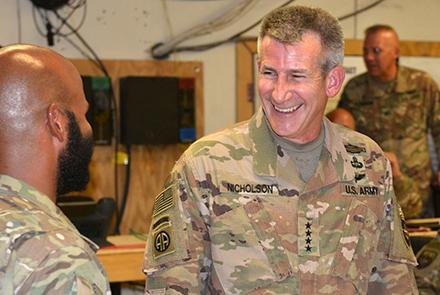Outgoing commander of NATO’s Resolute Support mission and US Forces-Afghanistan Gen. John Nicholson said at a press conference on Wednesday that despite a spike in violence the South Asia Strategy is working and has finally given coalition and Afghan forces the support they need to get to a negotiated peace with the Taliban.
Nicholson held his final press conference on Wednesday on the state of operations in Afghanistan before his replacement, Army Lt. Gen. Scott Miller, takes over through a change-of-command ceremony in the next few weeks.
According to Military Times, what the strategy needs, Nicholson said, is more time to realize gains from new offers for cease fires by the Afghan government and take advantage of a desire by some elements of the Taliban to negotiate with the Afghan government.
“We have an unprecedented opportunity for peace now,” Nicholson said.
Nicholson assumed command of US and NATO forces in Afghanistan in March 2016. Since then, he said the mission has seen Afghan forces take the lead in military operations, seen the impact of US forces having increased authorities to take offensive measures against the Taliban, Daesh and other militant groups operating there, and a psychological impact of the abrupt halt to the planned draw down of US forces there.
According to the Military Times, before the new authorities and South Asia Strategy were announced by President Donald Trump’s administration in August 2017, “we were on a glide path to reduce our forces, and eventually to close down the mission,” said Nicholson, who was the final Afghan general appointed by former president Barack Obama.
“At that time, the enemy had no incentive to negotiate, because we were leaving .... the enemy believed we had lost our will to win. And all they needed to do was wait us out.”
The US has increased its troop presence from 8,400 in the final months of Obama’s term to about 16,000 now, according to Congressional officials. The Pentagon no longer makes the numbers of actual troops on the ground available, instead provides its last reported figure of 14,000.
It is also unclear whether the gains Nicholson was highlighting will be enough for Trump, who has repeatedly questioned the cost of the war, Military Times reported. To date, military operations and stabilization efforts have cost more than $900 billion in Afghanistan, according to the Special Inspector General for Afghanistan Reconstruction. The fiscal year 2019 budget request for US operations in Afghanistan is $46.3 billion, a total which includes $5.2 billion to train Afghan security forces.
Meanwhile, Miller, Nicholson’s replacement, has already rankled some members of Congress during his June confirmation hearing when he told them "I can’t guarantee you a timeline or an end date,” as to when operations in Afghanistan would end, Military Times reported.
Both Nicholson and Miller have emphasized that with the number of terror groups operating in Afghanistan, to depart without reaching a negotiated peace with the Taliban would leave the U.S. mainland vulnerable to future attacks. Much of the training for the Sept. 11, 2001, attacks on the U.S. took place in Afghanistan.
Miller, who would be the 17th commander to oversee the Afghanistan mission, most recently commanded Joint Special Operations Command.

